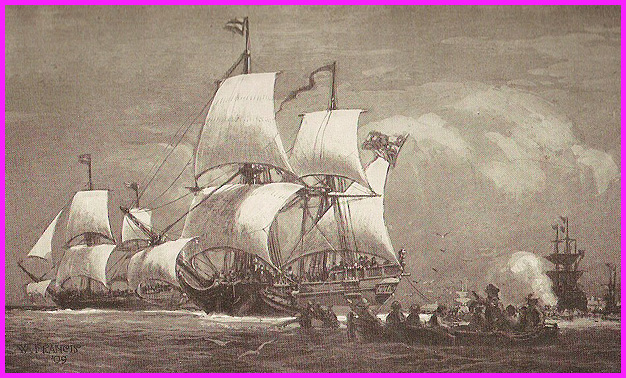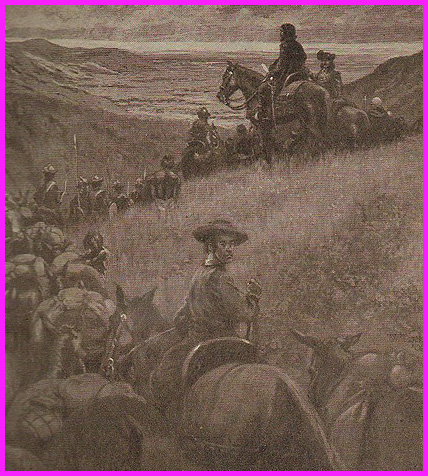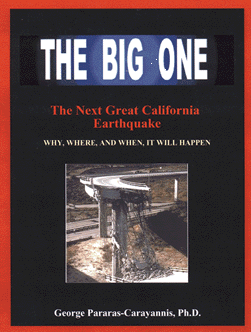CALIFORNIA - Brief History
George Pararas-Carayannis
(The following brief review of the early history of California and of the establishment of the missions resulted from historical research for accounts of early earthquakes and tsunamis in California preserved in mission records) ©1982 - 2010 Dr. George Pararas-Carayannis - All rights reserved

Background
The area known as California was first claimed for the Spanish Crown in 1542 by Juan Rodriguez Cabrillo when San Diego Bay was discovered. However, the region remained unexplored for more than two hundred years. In this time interval, New Spain's expansion in the northern frontier continued along a line of one hundred presidios (military garrisons or forts) in the present- day Northern Mexico and the American Southwest. However, in 1769, in response to concerns over possible intrusion by Russia and England into the area, the colonization of Alta (Upper) California, was initiated by the Spaniards.

The Departure of the Spanish Ship San Carlos from the Port of La Paz on January 10, 1769, under the command of Don Vicente Vila, for a voyage to California (Modified graphic from original 1909 drawing by W. Francis)

The Voyage of Portola and the Establishment of the Early Fransciscan Missions in California
Although San Diego Bay was discovered by the Spaniards in 1542, and Monterey Bay was sighted by seafaring Spaniards in 1602, the recorded history of California did not begin until 1769 with the arrival and colonization of Spaniards and Mexicans. On May 14, 1769, a small land party of Spanish soldiers and Indians, traveling through hundreds of miles of mountains and deserts, reached San Diego.
 (photo of Santa Barbara Mission)
(photo of Santa Barbara Mission)
The Governor of Baja California, the Spaniard Gaspar de Portola, and the Franciscan friar Junipero Serra, reached San Diego by sea with two ships six weeks later. Soon thereafter, the first of 21 Franciscan missions, the San Diego de Alcala, was established. Portola continued his journey north searching for the harbor of Monterey. When he reached the broad bay of Monterey, since it did not match the description of the early mariners, he pushed onward and reached another bay which he named "San Francisco."

Spaniard Gaspar de Portola signs agreement (original document from the Archives of Seville)
After sailing back to San Diego, he set out one more time to search for Montery Bay, which he reached on May 31, 1770. There, he established the settlement of Monterey and the mission of San Carlos Borromeo.

The Spaniards March to Monterey
Discovery of the Bay of San Francisco

Spanish Colonization
Spain's colonization strategy of California was intended to follow the same pattern as in Northern Mexico and in the American Southwest - through the establishment of missions, pueblos and presidios, each having a distinct function.
 Missions were intended to be the temporary facilities for turning natives into Christian citizens of the Spanish empire, thus providing a civilian population, a labor force and auxiliary military support for protecting Spanish interests in the area. By 1773, five missions had sprung up in California. These were San Diego, San Gabriel, San Luis Obispo, San Antonio de Padua, and San Carlos. The Franciscan Father Serra supervised their construction. These Franciscan outposts were the foundations on which California would grow. A total of twenty-one missions were established in California in the following years.
Missions were intended to be the temporary facilities for turning natives into Christian citizens of the Spanish empire, thus providing a civilian population, a labor force and auxiliary military support for protecting Spanish interests in the area. By 1773, five missions had sprung up in California. These were San Diego, San Gabriel, San Luis Obispo, San Antonio de Padua, and San Carlos. The Franciscan Father Serra supervised their construction. These Franciscan outposts were the foundations on which California would grow. A total of twenty-one missions were established in California in the following years.
The pueblos (towns) were supposed to be composed largely of families recruited in Mexico. They were expected to provide agricultural support for the presidio companies, while also expanding population centers and military reserves in case of invasion. However, only three pueblos were established under Spanish rule in California. These were the pueblos of Branciforte, of Los Angeles and of San Jose.
First survey and map of the Bay of San Francisco by Lt. Ayala (from original drawing attached to the Log of the San Carlos at Archives of Seville)
Finally, the presidios were the military outposts established to provide coastal defense from foreign invasion and to defend the missions and towns. In addition to their military role, they were the civil, economic and social centers for the frontier settlements of Alta (Upper ) California. They served as the centers for government and for communication within California and between California, Mexico and Spain. The presidios were the trading centers, which received and disbursed the annual supply of goods from Mexico, on which the entire population was dependent for survival. And the presidial companies, composed largely of married soldiers and their families, were planned as "seed" communities from which future pueblos would grow, thus strengthening Spain's claims to the region.
In 1769, presidios were established at San Diego and Monterey. The San Francisco Presidio was established in 1776, and the Santa Barbara Presidio in 1782. More than one hundred presidios were eventually established by Spain on its northern frontier. All of the presidios met to varying degrees the goals assigned to them by the Crown. Most were successful in fulfilling their role as "seed" communities. Pueblos grew up around the forts as military personnel retired from active duty and constructed adobe homes nearby. Military garrisons from the presidios, provided protection to the mission padres the (priests) and to the settlers for as long as they were needed. Once, in 1818, presidio soldiers defend the coast from a raid by the Argentine pirate Bouchard. Presidio couriers on horseback provided an efficient communication system - an early "pony express" system.


(Mission La Purisima)
Colonization by Land
Colonization by land begun of March 22, 1774, when a land party led by Don Juan Bautista de Anza and Fray Garce`s, with the help from the local Indians, found a way through the mountains and reached the San Gabriel mission. A trail from Mexico to the California colonies was finally established. The next goal of the Spaniards was the northern Bay of San Francisco, where a new major outpost was planned.
Anza returned to Mexico, marking the trail which had led him to Monterey. In Mexico City he reported to Viceroy Bucareli and received permission to organize an expedition of settlers. In October 1775, Anza assembled at Tubac, Mexico, an expedition consisting of 240 persons (mostly women and children), 695 horses and mules, and 355 head of cattle. The settlers reached the San Gabriel mission in early January 1776, and Monterey in March. In September of 1776, about two months after a new American nation was established far to the east, the Presidio of San Francisco was formally dedicated by Anza.
In 1781, an uprising by the Yuma Indians closed the overland route to California that had been so heroically pioneered by Anza, and Garce's. California was once more virtually isolated from both Mexico and Spain. The infusion of new colonists was cut off. California lacked population and manufactured goods. Foreign traders and foreign emigrants--especially Americans-- began to arrive in overwhelming numbers. In the following years, the Spaniards concentrated on the protection of New Mexico, which was considered an essential buffer protecting the rich Mexican heartland from the marauding Indian tribes of the American plains.

Find Legoland California discount tickets to take a low cost family vacation.
California Prospers
Meanwhile, California, the isolated frontier of New Spain, prospered under the mission system and the leadership of the visionary Franciscan Junipero Serra and the equally - able successor Fermin Francisco de Lasuen, and three other subsequent padres. Between 1769 and 1823, a chain of 21 missions had been built stretching from San Diego, 650 miles north, to the great Bay of San Francisco. These missions were linked by "El Camino Real," or the Royal Road. The missions were self-supporting and became the centers of Spanish civilization in California. The friars of these mission also acted as archivists of everything that was happening in California, and in these records they preserved accounts of earthquakes in the early history of California.
Mexico achieved its independence from Spain in February 1821, but the news of the event did not reach California until the following year. In November 1822, Luis Arguello became the first governor of California under Mexican rule. During the following years trading flourished. Americans began arriving overland-- much to the surprise of the Californians. On November 27,1826, Jedediah Smith, and a party of fur trappers who found a new trail through southern Utah, northwestern Arizona, and the Mojave Desert of Southern California, and showed up at the San Gabriel mission. The Californians felt uneasy about the presence of these Americans. Smith was placed under house arrest, but was released, finally provided he and his men would leave California at once by the way they had come. Smith and his trappers stayed for a while hunting, then found a new trail back home, traveling across the Sierra Nevada and the Great Salt Lake basin, In 1827, Smith returned to California where he was jailed but later released. His trails were now known to the Americans.

Decline Of Spanish Influence
Most of the twenty one California missions enjoyed great material success for a while, but the natives who were brought within their compounds were gradually decimated by foreign diseases to which they had no immunity. Thus the Franciscan friars were not able to deliver the expected large population of new Spanish citizens to the Crown. The mission properties, following secularization by the Mexican government in the 1830s, were distributed to soldiers in lieu of wages and to Mexican citizens in return for political favors. The Native Americans who remained were assimilated into the local society serving as laborers, household servants and vaqueros (cowboys).
Of the three California pueblos, the pueblo of Branciforte was unsuccessful from the beginning. There was no significant growth to the other pueblos of Los Angeles and San Jose which remained as small villages until well into the American period. The significance of the presidios also diminished as communities eventually assumed the political functions originally centered in the presidios. By the end of the Spanish/Mexican period in 1848, the presidios were in ruins, due to disuse and cannibalization of building materials. Most of the buildings of these presidios have nearly vanished.
In 1828, an uprising of the local Indian tribes was broken by Mariano Guadalupe Vallejo. In 1833, the greatest of California's Mexican governors, Jose Figueroa, assumed office. Vallejo became Figueroa's trusted protege' and he was sent to northern California to institute colonizing efforts, through new settlements, and to control the Indians of the north. In 1835, Figueroa died and a political turmoil followed. For a brief period, Juan Bautista Alvarado, Vallejo's nephew, forced his way until 1842, as revolutionary governor of California.

American Expansion
After the Louisiana Purchase of 1803, the American nation began its expansion. The Santa Fe Trail was established bringing Americans closer and closer to California. Texas was the first part of the American West won by the new nation.
Illegal infiltration of California by foreigners continued over the years. A series of events in 1846 cast much doubt about Mexico"s ability to maintain its hold on California much longer. Vallejo advocated annexation by the United States. Ironically on June 14, 1846, a small group of Americans acting on orders from John Charles Fremont, a young American officer, attacked the northern outpost of Sonoma, and captured and jailed Vallejo. The Mexican- American war had already started. Monterey had already fallen into the hands of the Americans. The Mexican-American war raged until February 2, 1848, when a peace treaty was signed. Mexico ceded to the United Stated what they already had, New Mexico and California. The Gold Rush of 1849 brought thousands more Americans to California.

| |
|
©1982 - 2010 Dr. George Pararas-Carayannis - All rights reserved
Last update: DEC 16, 2010 |
|
|
| |
|
|
|
|
|












 (photo of Santa Barbara Mission)
(photo of Santa Barbara Mission)


 Missions were intended to be the temporary facilities for turning natives into Christian citizens of the Spanish empire, thus providing a civilian population, a labor force and auxiliary military support for protecting Spanish interests in the area. By 1773, five missions had sprung up in California. These were San Diego, San Gabriel, San Luis Obispo, San Antonio de Padua, and San Carlos. The Franciscan Father Serra supervised their construction. These Franciscan outposts were the foundations on which California would grow. A total of twenty-one missions were established in California in the following years.
Missions were intended to be the temporary facilities for turning natives into Christian citizens of the Spanish empire, thus providing a civilian population, a labor force and auxiliary military support for protecting Spanish interests in the area. By 1773, five missions had sprung up in California. These were San Diego, San Gabriel, San Luis Obispo, San Antonio de Padua, and San Carlos. The Franciscan Father Serra supervised their construction. These Franciscan outposts were the foundations on which California would grow. A total of twenty-one missions were established in California in the following years.